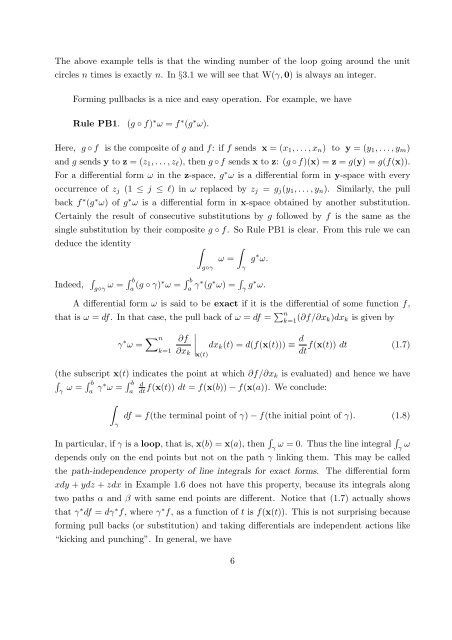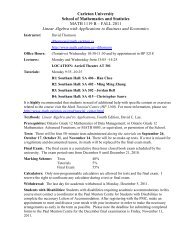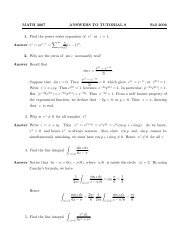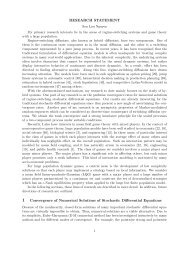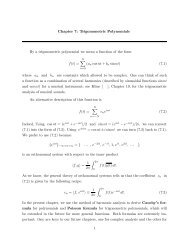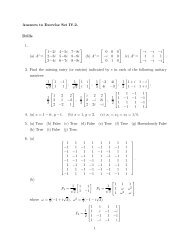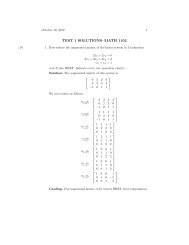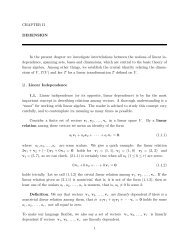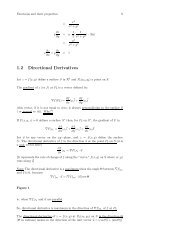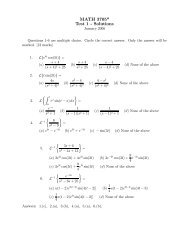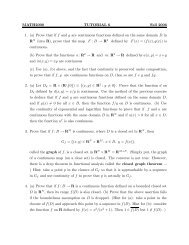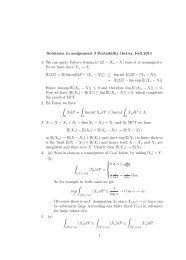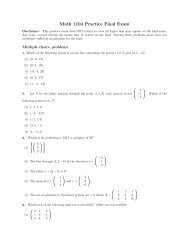CHAPTER 1. 1 — FORMS §1. Differentials: Basic Rules Differentials ...
CHAPTER 1. 1 — FORMS §1. Differentials: Basic Rules Differentials ...
CHAPTER 1. 1 — FORMS §1. Differentials: Basic Rules Differentials ...
Create successful ePaper yourself
Turn your PDF publications into a flip-book with our unique Google optimized e-Paper software.
The above example tells is that the winding number of the loop going around the unit<br />
circles n times is exactly n. In §3.1 we will see that W(γ, 0) is always an integer.<br />
Forming pullbacks is a nice and easy operation. For example, we have<br />
Rule PB<strong>1.</strong> (g ◦ f) ∗ ω = f ∗ (g ∗ ω).<br />
Here, g ◦ f is the composite of g and f: if f sends x = (x1, . . . , xn) to y = (y1, . . . , ym)<br />
and g sends y to z = (z1, . . . , zℓ), then g ◦ f sends x to z: (g ◦ f)(x) = z = g(y) = g(f(x)).<br />
For a differential form ω in the z-space, g ∗ ω is a differential form in y-space with every<br />
occurrence of zj (1 ≤ j ≤ ℓ) in ω replaced by zj = gj(y1, . . . , yn). Similarly, the pull<br />
back f ∗ (g ∗ ω) of g ∗ ω is a differential form in x-space obtained by another substitution.<br />
Certainly the result of consecutive substitutions by g followed by f is the same as the<br />
single substitution by their composite g ◦ f. So Rule PB1 is clear. From this rule we can<br />
deduce the identity <br />
Indeed, <br />
g◦γ<br />
<br />
ω =<br />
γ<br />
g ∗ ω.<br />
g◦γ ω = b<br />
a (g ◦ γ)∗ ω = b<br />
a γ∗ (g ∗ ω) = <br />
γ g∗ ω.<br />
A differential form ω is said to be exact if it is the differential of some function f,<br />
that is ω = df. In that case, the pull back of ω = df = n k=1 (∂f/∂xk)dxk is given by<br />
γ ∗ ω = n<br />
k=1<br />
<br />
∂f <br />
<br />
∂xk<br />
dxk(t) = d(f(x(t))) ≡<br />
x(t)<br />
d<br />
f(x(t)) dt<br />
dt<br />
(<strong>1.</strong>7)<br />
(the subscript x(t) indicates the point at which ∂f/∂xk is evaluated) and hence we have<br />
<br />
γ ω = b<br />
a γ∗ω = b d<br />
a dtf(x(t)) dt = f(x(b)) − f(x(a)). We conclude:<br />
<br />
γ<br />
df = f(the terminal point of γ) − f(the initial point of γ). (<strong>1.</strong>8)<br />
In particular, if γ is a loop, that is, x(b) = x(a), then <br />
<br />
ω = 0. Thus the line integral γ γ ω<br />
depends only on the end points but not on the path γ linking them. This may be called<br />
the path-independence property of line integrals for exact forms. The differential form<br />
xdy + ydz + zdx in Example <strong>1.</strong>6 does not have this property, because its integrals along<br />
two paths α and β with same end points are different. Notice that (<strong>1.</strong>7) actually shows<br />
that γ ∗ df = dγ ∗ f, where γ ∗ f, as a function of t is f(x(t)). This is not surprising because<br />
forming pull backs (or substitution) and taking differentials are independent actions like<br />
“kicking and punching”. In general, we have<br />
6


